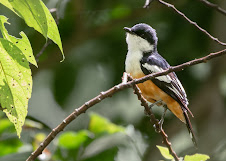
After finding the first Mussau Trillers in 45 years, this elusive triller was photographed by Joshua Bergmark.
|
Deep in the forests of Mussau Island in the Bismarck Archipelago, located northeast of the coast of Papua New Guinea, the search was on for the elusive Mussau Triller, not seen since 1979. In June, Joshua Bergmark led a group of birders through the forests of Mussau Island, where they found 3 of the island’s 4 endemic species – the Mussau Monarch, Mussau Fantail, and the Mussau Flycatcher; and that’s when the focus turned to the Mussau Triller, the rarest of the remote island’s endemic birds.
Like the monarch, fantail, and flycatcher, Mussau Trillers are forest birds, but they have been known to prefer taller trees in denser forest near the center of the island, which makes them inherently harder to find. Bergmark, co-founder and guide with Ornis Birding Expeditions, arranged for a vehicle to take the group deeper into the forest with high hopes.
Most of Australasia’s trillers have gray, white, and black plumage, but Mussau Trillers have distinct light orange-colored belly and vent plumage. They eat insects and fruit, and are members of the Cuckooshrike family of birds, found widely across the Eastern Hemisphere. After not being reported for more than 40 years, the Mussau Triller was listed as a “lost bird” by the Search for Lost Birds project, a collaboration between the American Bird Conservatory (ABC), Re:wild and BirdLife International to document birds that have not be reported for an extended period, raising important questions about their well-being in the wild.
After driving for an hour, the birders began to walk for a distance, checking every bird they saw along the way. At the base of a very steep hill, some people stopped and waited for a ride up the steep ascent, while others began hiking uphill. One of the birders who decided to wait noticed a couple of small birds quietly perched in a nearby tree, and wouldn’t you know it, he spotted a Mussau Triller – the first one reported in 45 years! The other members of the group returned soon afterwards and together the birders took the first known photographs and sound recordings of the species while documenting 9 Mussau Trillers in 3 small flocks.
Usually, you hear these birds before you see them, but in this case one of the birders saw it first, according to Bergmark. “They were moving around with the other birds and feeding, doing their own thing while we watched them.”
Bergmark’s company, Ornis Birding Expeditions, specializes in birding tours to remote regions around the world. During the same June trip, Bergmark also took his first photographs of the Manus Dwarf Kingfisher (a bird endemic to Manus Island, located west of Mussau isle) that was considered “lost” from 2002 until 2022. He also photographed the New Hanover Mannikin, an endemic species on New Hanover Island, located south of Manus Island, which was on the verge of being listed as a lost bird before it was documented.
“Every time we get out to one of these rarely visited islands or places, and just get on the ground, walk around, we see things that few other people have seen; it’s exciting,” Bergmark shared. “Yes, it’s exciting, always.”
For more information, especially related to conservation concerns for super-rare or rarely encountered birds, often in remote areas of the world, you can refer to the original article published online by Birds of the World at FOUND! Mussau Triller rediscovered in Papua New Guinea - Birds of the World